
Considering its barely credible weight, the warmth on offer from this combo of sleeping bag and mat is nothing short of outstanding, says John McKenna. It's a big investment, but one that mountaineers, backpackers and bikepackers may consider game-changing.
With the Mythic Ultra 120 Modular Down Sleeping Bag and Ultrasphere 4.5 Sleeping Mat, Rab have produced their lightest and most packable sleep system. Featuring premium quality materials and clever design features that help keep the weight and pack size to a minimum, this is not your average bag and mat. Over late spring and into summer we used this combo for ultralight overnights in the Scottish hills, a setting for which it proved ideal.
In Use
Ultralight backpackers, multi-day runners, bikepackers and mountaineers alike will all find a lot to like in this combination of mat and bag. I've mainly used them for lightweight overnight trips in the Scottish hills, and for future use I'm keen to see how its compact size and low weight will benefit my mountain trad trips with a base camp near remote crags. It'll come as no surprise that the main benefit of this sleep system is its weight and packability. It's amazing to head off for an overnight trip in the hills with what feels like just a small daypack.
The sum of the two is greater than its constituent parts. The bag uses extremely lightweight, compressible 900 hydrophobic down only where needed—on the upper bag and under the legs, while the rest of the insulation comes from the mat, saving weight but requiring a high-quality mat and connecting straps to prevent exposure in non-insulated areas when moving during sleep. This is one reason why it makes sense in this review to talk about the two as a 'sleep system' rather than separate items.
Because of this design, Rab couldn't use an EN warmth test but recommends comfort down to 0°C when used in conjunction with the Ultrasphere 4.5 mat. I've comfortably used it with a small down jacket on colder nights, around 5°C, so 0°C seems realistic - although you might need to add some clothing. Since I usually pack a down jacket for camping, it makes sense to rely on it and reduce sleeping bag weight for ultralight trips.
The main drawbacks I've experienced here are primarily in durability and comfort. This will vary for both the use scenarios and type of sleeper you are i.e. side sleepers may find the narrow shape of the mat and mummy like design of the bag quite restrictive, especially when using the attachment straps to keep the bag orientated upwards - you really don't want to have any of your underside lifted off this narrow mat when you are relying on it for insulation instead of your bag. This isn't to say the mat or bag are uncomfortable - I've felt rested after each night's sleep - but there are inevitable trade-offs in comfort due to the focus on reducing weight and packed size.
It's amazing to head off for an overnight trip in the hills with what feels like just a small daypack
Extended use in environments where abrasion is more likely could see some of these ultralight materials wear out faster than a more durable product. For this reason I have tried to be as careful as I can whilst using this sleep system and will tend only to use it when the scenario calls for lightness, as I don't want to prematurely wear through such a great product, bearing in mind both the environment and my wallet.
Mythic Ultra 120 Sleeping Bag - £390
Materials and Construction
To achieve minimal weight and pack size, every aspect of the bag's design and material choice has clearly been carefully considered. The 900 fill power down provides lightweight, compressible insulation, while its hydrophobic treatment ensures performance in damp conditions without clumping.
The main fabric is a lightweight 10D Atmos Recycled nylon—durable for its weight, though it will require care to avoid damage over time. This fabric allows the down to loft well and is windproof, fast-drying, and water-resistant for added protection in less than ideal conditions. Inside, a similar 10D fabric with a TILT lining reflects heat back to the body, boosting warmth without reducing breathability or comfort. Despite my initial concerns, the TILT lining doesn't feel crinkly or uncomfortable.
Weight and pack size
At a barely-credible 334g on the home scales, and packing down to the size of a small melon, this tiny sleeping bag opens up way more potential for any ultralight activities I want to pursue. To cut just a little extra weight, I stuff the bag into the mat's pump sack and ditch the stuff sack for the sleeping bag.
Features
As well as the lack of insulation on the underside of the torso, the sleeping bag does without a conventional hood. This is a good weight-saving measure in a model that is not intended for serious cold, since you could always wear a hat if you were getting chilly up top.
The diagonal zip from shoulder to stomach makes getting in and out of the bag a bit harder than with a full length zip. It's a small price for the warmth, weight, and packability benefits. However, the anti-snag design isn't foolproof, and I've caught the thin fabric a few times - though with careful use, it hasn't caused any damage.
Further cutting weight, an ultralight pillow can be created by using any other clothing you aren't wearing whilst sleeping, by stuffing this into a hood sleeve at the head of the bag, thus reducing the need to bring a dedicated pillow. A smart little feature.
Ultrasphere 4.5 Sleeping Mat - £170
Materials and Construction
The mat's main fabric is a 20D Recycled Polyester with TPU lamination for durability. It feels strong for its weight, and I've had no leaks - but I do try to inspect the ground for sharp twigs and pebbles first. The PFC-free DWR adds moisture resistance, preserving the mat's thermal properties.
Inside, two layers of TILT lining reduce radiant heat loss without being noisy. Offset weight-saving cutouts also help trap warm air and prevent convection currents inside.
With all of these clever design choices, Rab have been able to produce a very light mat which still has a pretty warm R-value of 4.3.
Weight and pack size
A tiny 379g on the home scales for a mat that goes from a small roll to 183cm x 51cm x 8cm is quite impressive. Thickness wise it's a comfortable mat to lie on, soaking up any uneven ground and giving a padded sleep, although the tapering shape of the mat means a bit of a tradeoff on comfort for these size and weight savings. Larger users or restless sleepers might notice the difference.
Packed down to 15cm by 9cm, something like the size of a can of beer, it takes up a tiny amount of space in my pack - although like my experience with Rab's other sleep mats, the stuff sack can feel very tight and I feel like I need to pack this away perfectly in order to fit inside.
Features
The 2-way valve is easy to use and low profile. I've found it relatively easy to let air out when lying on the mat to reach my desired firmness, although I do think there are some better valves on the market for convenience of use.
The stuff sack includes a small repair kit for any accidental punctures, though thankfully I haven't needed it yet.
It also comes with a pump sack for inflating the mat, which usually works within a couple of minutes using 4-6 sacks of air. Annoyingly, I can't fit the pump sack back into the stuff sack with the mat, so I use it as a stuff sack for my sleeping bag to save a bit of extra weight.
Ethics and Environment
Rab provides a 'Material Facts' sheet for all their products, detailing their environmental impact. Both products are PFA-free, and the recycled content varies, with the bag's outer fabric being 100% recycled. This info is available on each product page. All down is certified RDS.
Summary
I've really enjoyed using this sleep system, and we'd say the warmth it provides for its minimal weight and packed size is nothing short of outstanding. The premium materials and clever design, from the mapped insulation to the integrated pillow, makes it a truly impressive combination. While comfort and durability take an obvious hit, they are still remarkable given the low weight and minimal packed size. Yes it's a major outlay in cash terms, particularly for the sleeping bag, but for uses where weight savings are key this ultralight system opens up adventures that might not be possible with bulkier gear.
























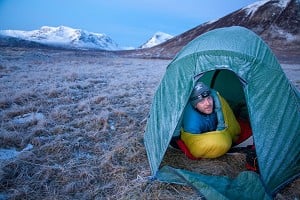

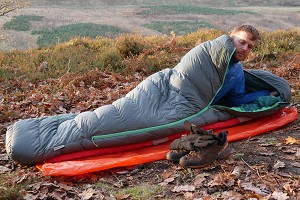
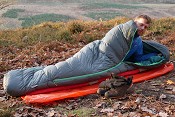
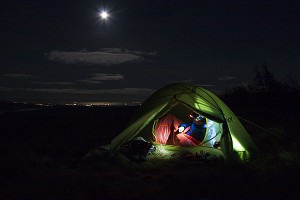
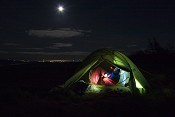
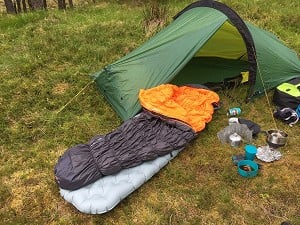
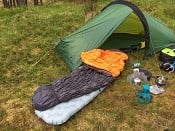
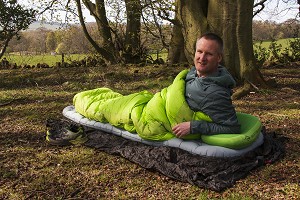
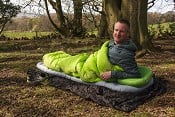

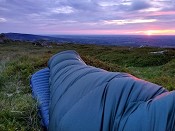
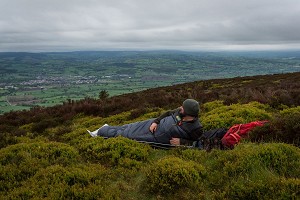
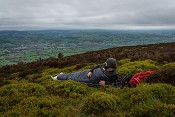

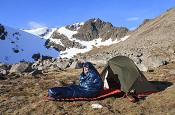




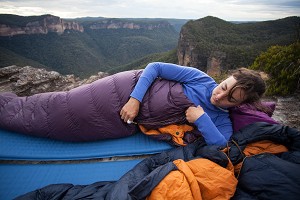
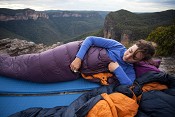
Comments
Thanks for this John - it looks like a really interesting concept. I had a tryout of one of those bags in George Fisher, and I was surprised how roomy it was. I wasn't able to try combining it with the mat though.
I hope this encourages more manufacturers to come up with symbiotic pairings like this.
In many ways they have https://www.ukclimbing.com/gear/camping/sleeping_bags/therm-a-rest_hyperion_32f0c_sleeping_bag+neoair_uberlite_mat-12246 I think I did that review in 2019. I'm not trying to say Rab is copying or anything, just that they have come up with a very similar solution to Thermarest by following logic - minimizing sleeping bag weight by accepting that for many any insulation below the sleeper is redundant, so do away with it. I still regularly use the bag and mat from my review as they are still by some way the lightest sleeping set up I have.
Good stuff, Toby. The Hyperion 32 is my current bag for the same reason. I only pair it with a Thermarest mat in winter, though (an Xtherm NXT). In the warmer months I lie on a Klymit X-Frame, which is probably out of design intent but seems to work (the lower down squidges into gaps in the mat, making it surprisingly insulated)
I've just sent Dan some copy on super-mega-ludicro-ultralighting that may be interest.
Straps under the mat? Tried that on my homemade quilt 8 years ago. Doesn't work. You spend all night lying still, trying not to let the cold air in. IMHO, you need a sheet of fabric to close the underside, to prevent draughts. Adds 100g but makes the quilt 10 times better.
Probably less than 100g with modern lightweight fabrics, Dave.
Regarding if any manufacturer is copying others, the concept has been active since at least the mid 80s. I think the first one I saw was a sample from Rab.